Examples of Modern Art and the Artists That Create It
In most historic senses modern art has been around for quite a while. The range of modern spans from as early as the 1860s to the 1970s in most art history books.
However, in reality, a large number of very influential modern art creators have lived and produced their work decades later. Some are even recognizable in other genres, such as politics and entertainment.
But, the common theme is the same. Modern art involves an intentional avoidance of traditions and a full embrace of experimental art design. Here are some examples of works from important mid-century to present artists. Here we look at the mediums they used, their influences and how some of their leading works were created.
Andy Warhol
The Star (1981)
The Star was created by Warhol as a screenprint emphasizing a primary red visual, highlighted by diamond dust. The entire work was fabricated on Lenox Museum Board. It was a vivid and striking piece from Warhol’s later years and showed that his statement, “art is what you can get away with” was still active and working in the artist’s favor decades after his start as a professional illustrator.
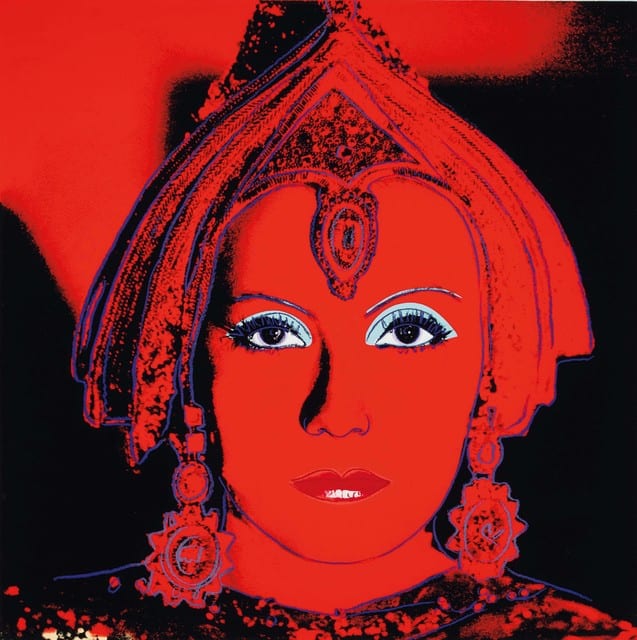
The actual image was an original photograph of Greta Garbo. Warhol then applied his perspective using color saturation and key highlight points to draw attention. Despite the bold, almost garish coloring, Garbo looks real and sentient, almost as if she were breathing behind a red filter window looking back at the viewer. The print was a run of 200 copies all signed by Warhol, and it was a key item in the Myths Portfolio created by Warhol as a set.
– The Nun (1983)
Combining artistic color with the movie screen, Andy Warhol blended pop-art with one of his admired actors, Ingrid Bergman. In this work, Warhol takes an image of her from the movie, The Bells of St Mary’s, and frames her visage permanent in a modern art format.
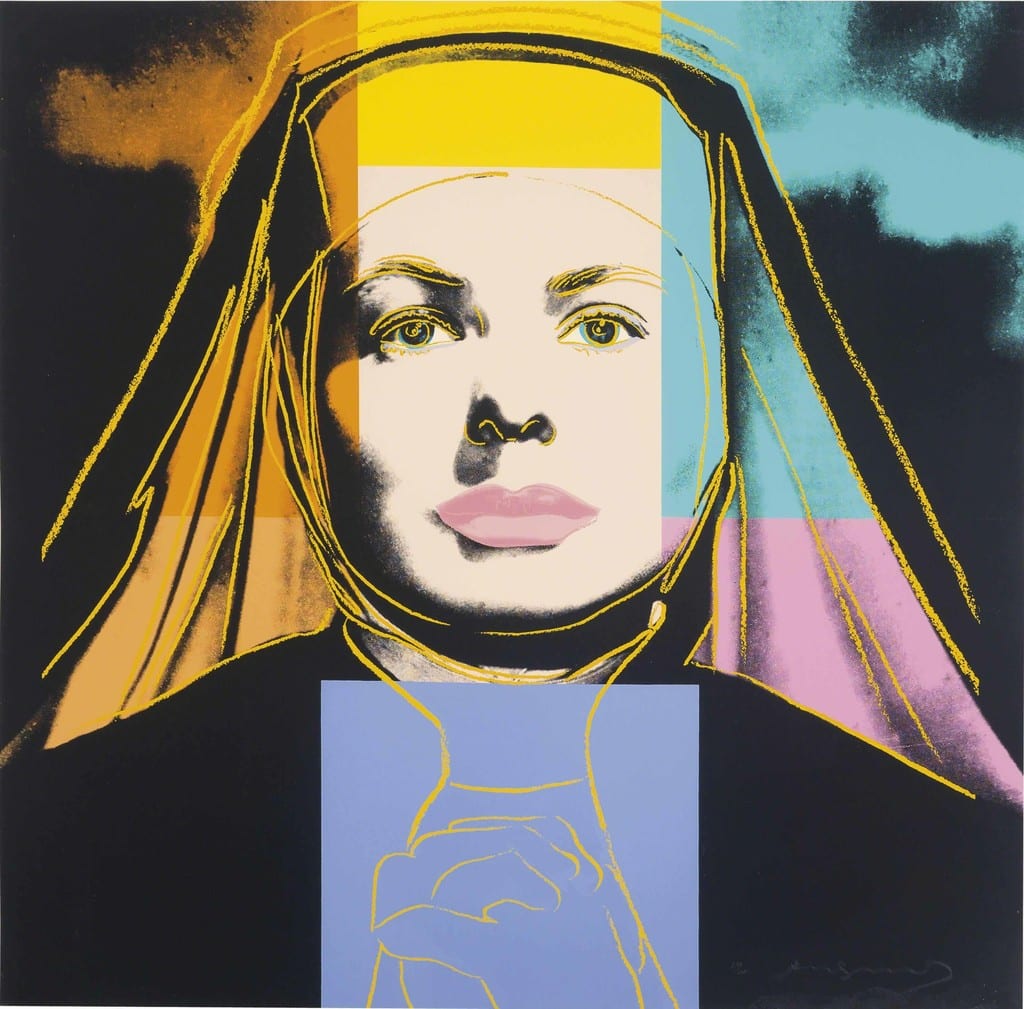
Looking at The Nun, one find themselves going back and forth… between whether it is a painting or a photograph or something in between. The Nun thus becomes a classic of Warhol style, taking an image of popular film and turning it into another form altogether.
The Nun was not one of Warhol’s early works. Unlike much of his early imagery associated with the heyday of the 1960s. The Nun was created in 1983 towards the latter half of Warhol’s career and his life. He died only four years later in 1987.
James Rosenquist –
My Mind is a Glass of Water (1972)
With a play on words, Rosenquist’s work showing a glass of water is a bit of a visual mental puzzle. Is the image of the glass of water full, or an upside-down glass of water empty? Or, is the glass of water sitting on another field of water reflecting the same glass upside down?
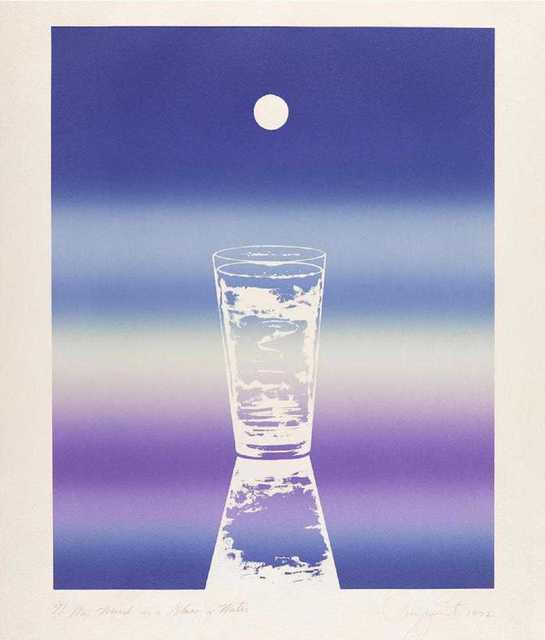
Through this thought-provoking work, we can almost glean insight into Rosenquist’s imagination and perspective. This lithograph was one of Rosenquist’s later works but it wasn’t his last. Rosenquist kept producing well into the new century, only passing away recently in 2017.
His influences reflect styles of Roy Lichtenstein as well as Robert Rauschenberg, and Rosenquist had a bias towards big displays. This was an evolution of a previous experience; Rosenquist had worked for a while as a billboard artist in the late 1950s. Given some of the work that the artist produced in the 1960s, My Mind is a Glass of Water tends to seem tame in comparison.
However, the painting is also a prime example of how modern art moved away from the hyper-political or social commentary of the 1960s into far more abstract topics altogether by the next decade.
Mr. Brainwash –
Work Well Together (2018)
Looking at the painting, Work Well Together, one might think the artist produced a cynical response to Normal Rockwell’s original subject with a Pop-Art perspective. That opinion wouldn’t be too far off the mark. Thierry Guetta, aka Mr. Brainwash, produced this mixed media work via spray paint and application of a silkscreen acrylic medium.
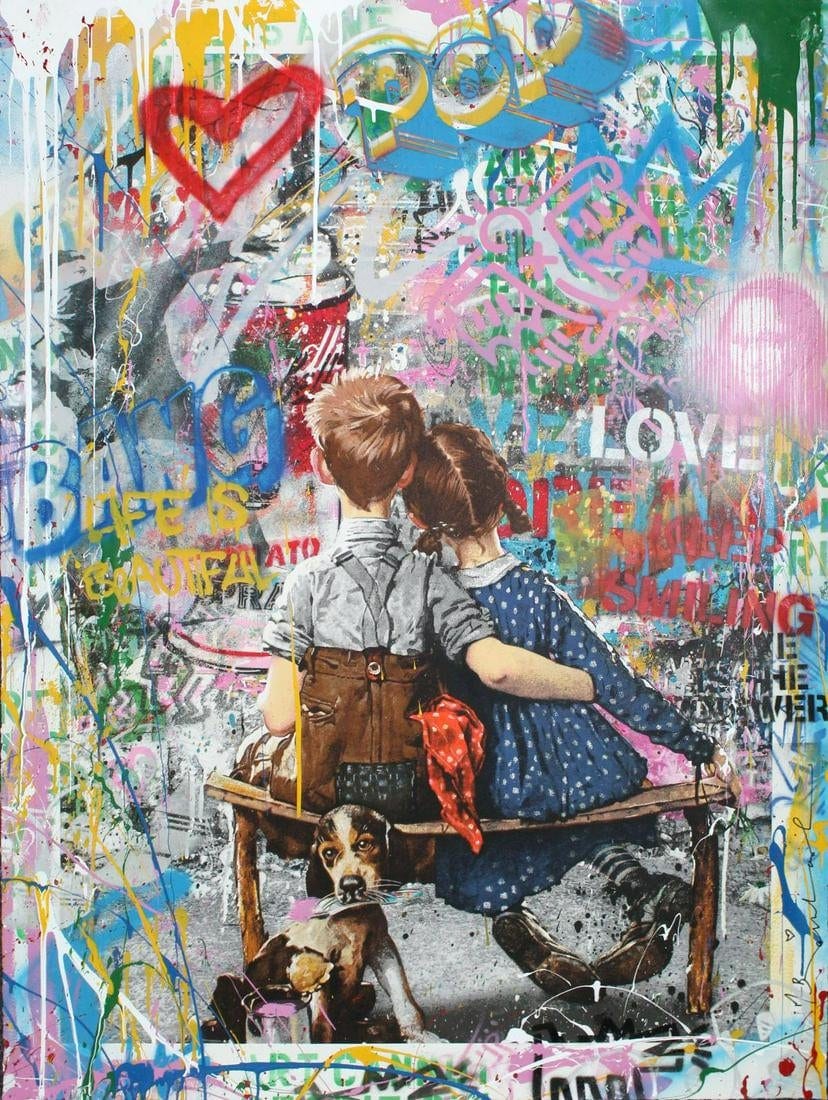
Thierry’s art identify has been a fusion of influence from both Shepard Fairey and Banksy. There’s a common thread of street art, and a sense that these artist’s may have impacted Mr. Brainwash and his later work. Thierry Guetta’s scope of work and influence, has been a bit of a rocket ship rise, going from a complete unknown… to designing album covers for Madonna and presenting as the main headliner for Art Basel Miami and New York.
Mr. Brainwash’s style is very much a food-processor mashup of street art and pop images overlaid with recognizable icons. One gets a sense of graffiti blather all over a classic visual from decades prior when looking at Guetta’s work.
Julian Opie –
New York Couple (2) (2019)
Born in 1958 in England, Opie gained his primary artistic insights working with and studying under Michael-Craig Martin during the 1980s. His first works were far more involved due to integrating steel sculpture with paint.
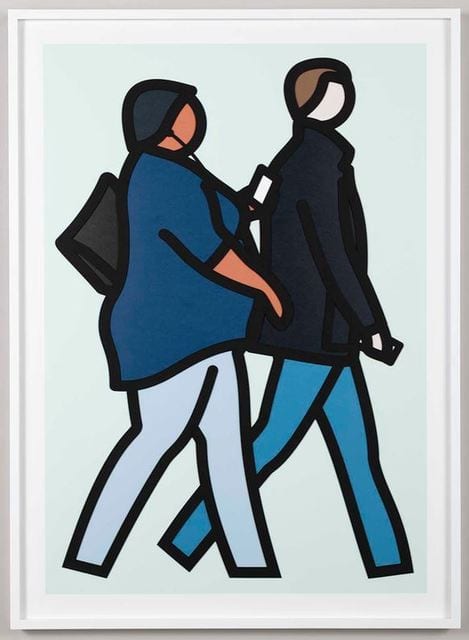
By the time the 1990s started, Opie was counted among the New British Sculpture movement, but it was just his beginning. Moving into painting, Opie began to stand out dramatically in the 2000s with a regular flow of imagery and paintwork.
The New York Couple (2) was part of a series of panels Julian Opie created, visualizing different people he saw as ideal models for his comprehensive display of urban America, which was a bit ironic since Opie lives and works out of London. Nonetheless, Opie’s images are striking, and he is regularly called upon for graphic work and similar as a result.
Roy Lichtenstein
Reflections on Minerva (1990)
Twenty-five years after his earliest famous works, Lichtenstein’s work Reflections on Minerva continued a throwback to his original clashing style of comic book imagery with large sized modern art graphics. Developed as a lithograph via screenprinting, the work combines mixed media in a disjointed fashion. As if the artist was developing an abstract version of his early style.
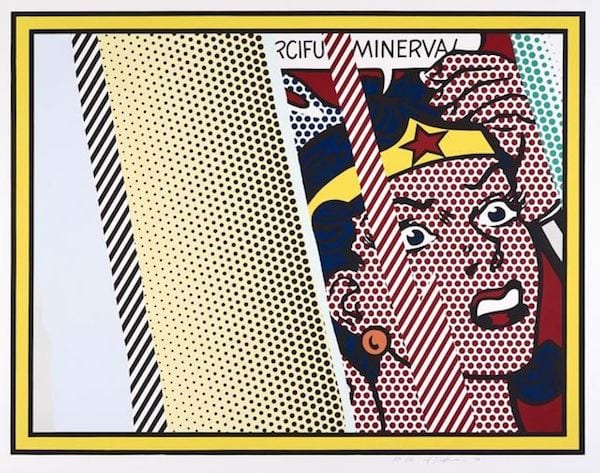
This particular painting was part of seven works Lichtenstein put together at the end of the 1980s. In this iconic Pop Art work, Relfections of Minerva-plays with the idea of emulating a glass reflection obscuring a primary image.
Lichtenstein was playing with a new idea and evolving it from original templates to a new format altogether. In doing so, the artist reinvented his old classic of the comic book image transformed and reinterpreted into modern-day commercial graphic shapes and colors.
Crying Girl (1964)
Roy Lichtenstein produced several works that were used again and again in marketing. His work spanned multiple mediums and could be found as album covers, social commentary, and representation of American life. However, Lichtenstein’s focus was to create an artistic image of female identity.
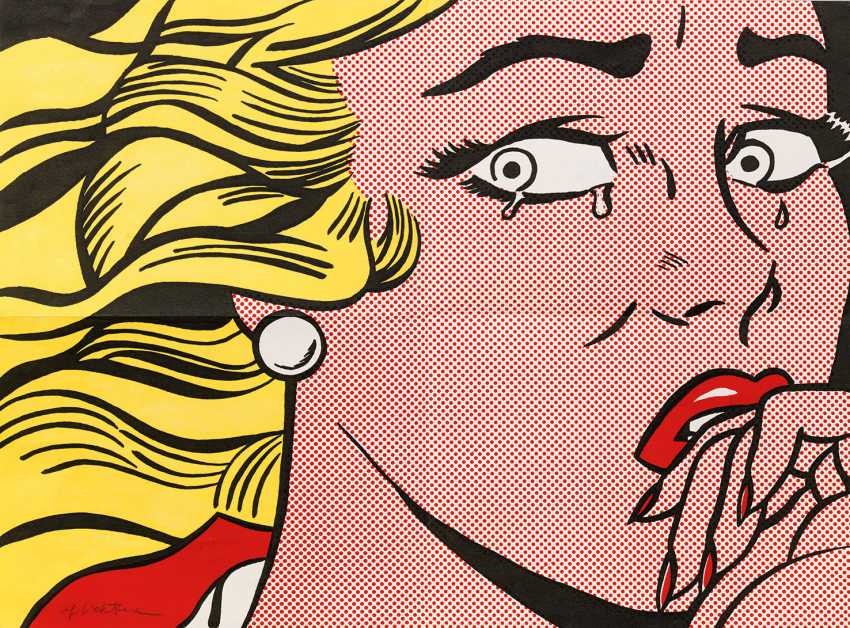
It was a face of angst and frustration against an “ideal” of how women were supposed to behave versus what they wanted with equality and personal identity instead. The Crying Girl visualizes the woman in Lichtenstein’s mind, feeling trapped in a persona that isn’t her, thus the emotions and helplessness of the tears.
The painting is a clash of social norms. On the one hand, the girl is expected to represent the mainstream young woman who has to maintain the looks and behavior of a weaker class.
On the other hand, the comic book nature of the image clashes with the traditional view of acceptable art at the time, making the woman’s “traditional” image a takeoff of a comic book like illustration instead. This goes in line with the girl’s frustration of feeling trapped and stuck in her social role, per Lichtenstein.
Crafted as a lithograph on paper, the Crying Girl has been associated with 1960s modern art and could be titled today as a prime example of “classic” American modern art. The official prints continue to be a favorite at a pop art auction when they come up.
Jean-Michel Basquiat –
Jaw Bone of an Ass (1982)
Designed as part collage, part communication, Jaw Bone of an Ass throws all sorts of images together by using words instead of shapes. It is one of the few art pieces that include references to Egypt, Rome, the Macedonian Empire under Alexander, Lincoln’s Emancipation Proclamation, and the Revolutionary War’s John Paul Jones all in the same work of art.
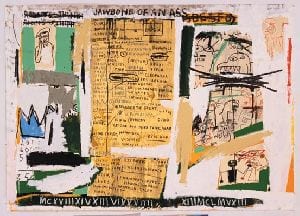
Taken in terms of its content versus just the physical first appearance, Jaw Bone of Ass provides a political and social commentary from Basquiat’s perspective. How that complex Rubik’s Cube of an assembly comes together is the viewer’s challenge to figure out.
Born from parents combining a heritage of Haiti and Puerto Rico, Basquiat was a typical generation of mixed backgrounds common in New York City. And that perspective combined with the ultra-urban environment one gets with living in Manhattan came out in Basquiat’s art.
The young artist quickly gained fame and recognition as he integrated street art, punk and hip-hop music, and youth in visual packages. Unfortunately, Basquiat also ended his life prematurely with the use of drugs and overdosing.
By 1992, Basquiat’s art was being displayed at the Whitney Museum of American Art. Socially, Basquiat played on social inequalities. He contrasted poverty against material wealth and highlighted realistic segregation against the ideal of diversity and equality.
George Rodrigue – Paper Ribbons and Me (2000)
As a Southerner, born and raised right after World War II in Louisiana, Rodrigue could have focused his artwork on history and landscape. There was plenty of inspiration in the deep south during his growing years.
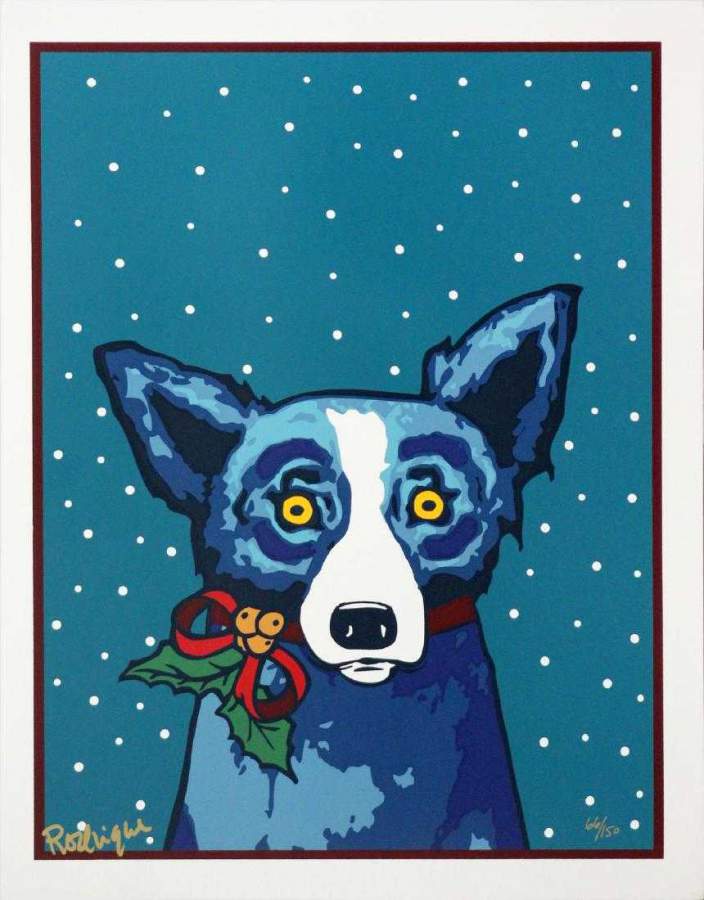
George Rodrigue- Paper Ribbons and Me, 2000
But George Rodrigue took on most of his artistic inspiration in the 1960s when he spent a tour in Los Angeles at the Art Center College of Design. When he was done, the distinct Rodrigue style began to appear. Along the way, his Blue Dogs became a theme in Rodrigue’s paintings.
Paper Ribbons and Me, created at the new Millennium, was specific for the holidays, resonating well with the Christmas season and the sense of big change coming with the new decade.
Completed as a serigraph on paper, Rodrigue’s painting represents a later evolution of the Blue Dog image, a recurring symbology Rodrigue favored in a number of his works. Many of Rodrigue’s works have been in high demand and have priced well at modern art auctions.
Jeff Koons – Balloon Dog (2015)
Born in the 1950s, Jeff Koons is well recognized for his art toy balloon representations, ranging in sizes from hand sized to building sized works. The Balloon Dog shapes in various forms have been extremely popular. Some of these have become significant placements in public locations as well as part of private collections via auction.
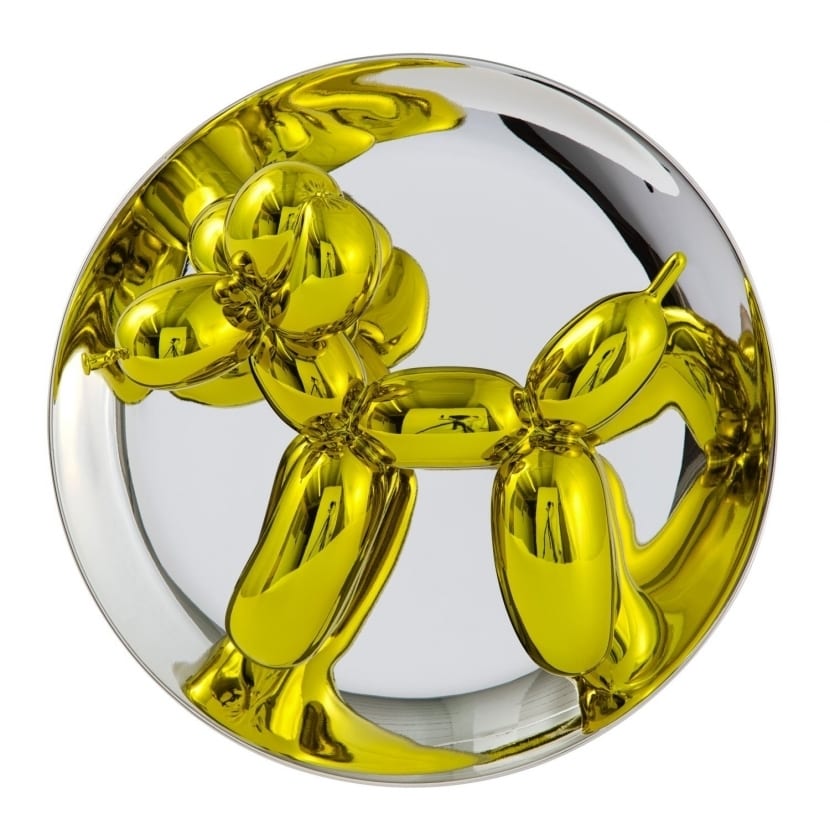
The Balloon Dog, finished in 2015, is simplistic in its form, but the art piece also resonates with multiple generations. Most have had a balloon animal made for them at some point at a circus, fair, expo or park when growing up. It is no surprise, Koons’ work has sold well at more than one contemporary art auction.
There are many other examples of Pop, Modern & Contemporary art, but the above artists and their works are some of the most iconic of these Art genres, spanning a period from the 1960s to the last decade.
Comprehensively, the above provides viewers and fans of fine art a portfolio of the Modern Art movement, as well as examples of how the genre continues to keep providing insight on the social trends of the times.
